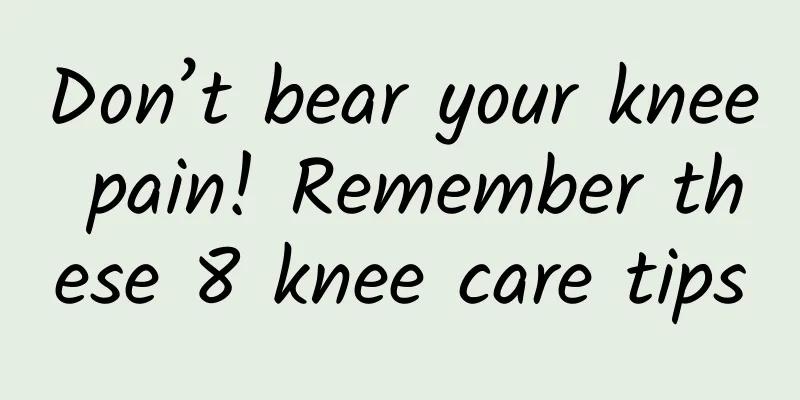Don’t bear your knee pain! Remember these 8 knee care tips

|
As we enter summer and temperatures soar across the country, weight loss has become a hot keyword again, and the trend of climbing stairs to lose weight is even more popular on the Internet! Recently, the exercise method of "climbing stairs on an empty stomach and losing 20 pounds in a month" has become popular and has been praised by netizens as "the most effective aerobic exercise for fat reduction". Today, #Workers lose weight by climbing 21 floors a day and losing 13 pounds a month# has become a hot search, triggering heated discussions among netizens. Recently, Ms. Zhong from Lishui, Zhejiang successfully lost 13 kilograms by climbing stairs. Ms. Zhong said that she would climb the stairs after get off work every day, climbing 21 floors every day, a total of 4 to 5 times. I persisted for nearly a month and a half, ate three meals a day normally, and lost twelve or thirteen pounds. Ms. Zhong said that climbing stairs to lose weight can be done regardless of the weather, it is free and can be done at any time. Ms. Zhong's stair climbing weight loss method has attracted many comments from netizens: I made up my mind to climb the stairs and check in on an empty stomach. I'm a little tempted, I'll try it tomorrow. I climbed stairs for 15 days and ate a normal diet, but I didn't lose a pound. My knees still felt a little uncomfortable. I forced myself to persist for two days, and the pain got a little worse. Does climbing stairs hurt your knees? There are many opinions. Some people are excited, while others are worried about their knees - climbing stairs to lose weight will hurt the knees. Does climbing stairs really help you lose weight? Does it hurt the knee? Although climbing stairs has been labeled as the "dumbest" weight loss exercise, it is still one of the better weight loss exercise choices when there is no time or space. Its weight loss advantages are obvious: simple and convenient, and high calorie consumption. If you climb with a weight of 60 kg, you will burn about 480 calories per hour. Although climbing stairs is fun, it will hurt your knees! Because the human knee joint bears most of the body's weight, the flexion and extension of the knee joint when climbing stairs will be subjected to repeated "impacts". The load it endures is several times that of normal standing, which can cause damage to the knee joint and induce knee joint diseases. For normal people, the load can be adjusted and repaired in a short time. However, for the elderly or people with knee diseases, excessive activities will aggravate the knee diseases and cause adverse effects. In addition, as people age, their bones will degenerate and proliferate, and wear and tear of the meniscus will cause knee arthritis. The weight that the human knee joint bears when going up mountains, stairs, and slopes is about three times the body's normal weight. Therefore, climbing mountains, slopes, and stairs will damage the knee joints, so you must try to avoid these exercises. Doctors remind: Climbing stairs to lose fat and weight is not suitable for everyone. If the climbing posture is incorrect or you already have knee problems, climbing stairs will increase the burden on the knee joints. The relationship between knee weight bearing and body position 1. When lying down, the weight on the knees is almost zero. 2. When standing up and walking, the load on the knees is about 1~2 times. 3. When going up and down slopes or stairs, the load on the knees is about 3 to 4 times. 4. When running, the load on the knees is about 4 times. 5. When playing ball, the load on the knees is about 6 times. 6. When squatting and kneeling, the load on the knees is about 8 times. Therefore, playing basketball, badminton, tennis, mountain climbing, squatting, kneeling, long jump and other sports will cause certain damage to the knee joints. How does the human knee joint age? Knee degeneration timeline: 1 Before 15 years old The knee joint is in the development stage, and growing pains during adolescence often occur near the knee joint. 2 15~30 years old The knee joint is in "perfect condition" and works tirelessly. As long as the knee joint tissue is not damaged, its presence is basically unnoticeable. 3 30~40 years old The patellar cartilage undergoes mild early wear and tear, and then goes through a fragile period, with short-term knee pain that lasts for a few weeks to a few months, which some people may not even notice. The patellar cartilage is a layer of 3 to 5 mm thick transparent cartilage inside the human knee joint, which can cushion the impact of movement on the knee joint. However, since there is no nerve distribution in the patellar cartilage, it will only sound a "warning signal" once during the fragile period before the entire layer is worn out. During this period, strenuous exercise should be avoided. It is also from this time that the knee joint can no longer be used as you please. 4 40~50 years old After walking a long distance, the inner side of the knee joint is prone to soreness, which can be relieved by gently rubbing it with your hands. In the knee joint, the function of the meniscus is to cushion shock and maintain stability. 60% of the body's weight is supported by the medial side of the knee joint, so degeneration of the medial meniscus occurs relatively early. Because there are nerves distributed on the meniscus, people can feel pain during the degeneration process. The occurrence of this phenomenon reminds people that they need to start maintaining their joints. 5 After 50 The knee joint will feel obvious pain because the "service life" of the patellar cartilage has reached the end, the entire layer of cartilage has been worn out, and arthritis has occurred. At this time, you should use your joints sparingly and reduce strenuous exercise, especially going up and down stairs and climbing mountains. If necessary, you can use crutches to reduce the pressure on the knee joints. If you need to climb stairs frequently, How to protect your knees? 1. When climbing stairs, do not rush up quickly. Make sure your entire foot is on the ground. When pushing back, use your heels to exert force. This will not only exercise your thigh and buttocks muscles, but also reduce knee joint injuries. 2. When climbing stairs, the toes can be slightly tilted outward 30 degrees, and the knees and toes should be in the same direction, not inward or outward. When climbing, pay attention to flexing the hips, straightening the waist and back, and sitting the buttocks slightly back. This can ensure effective exercise while reducing damage to the knee joints. 3. When climbing stairs, try not to lift heavy objects. If you have to lift something, you can choose to take a rest after climbing half a flight of stairs, or lift the object in several times. Do not carry too much weight at one time, as this may cause more serious injuries. 4. When climbing stairs, try to go up with the good leg up and down with the bad leg down. That is, if one knee has problems and the other knee is still healthy, you should go up the stairs with the healthy leg first, and go down with the affected leg first. This way you can use the muscles on the healthy leg to support the body and reduce wear and tear on the affected knee joint. 5. If you have problems with both knees, you should hold the handrail when climbing stairs, take one step at a time, and use the strength of your arms for support to reduce the pressure on your knee joints. 6. When climbing stairs, be sure to wear suitable shoes. Try to wear flat shoes instead of high heels. Because when wearing high heels, the center of gravity will move forward and deviate from the center. The body will be unstable and prone to falling forward, and the knee joints may be forced to bend, which will cause greater damage to the knee joints. How to take care of knee pain in daily life? Keep these 8 points in mind 1. Don’t walk for too long. If you feel any discomfort in your knees, you should take a rest immediately. 2. Do not do high-intensity exercise, such as running, high jump, long jump, etc. 3. Avoid half-squatting, full-squatting or kneeling postures, such as horse stance. 4. Do not perform semi-flexed rotation movements of the knee joint to prevent half-plate injury. 5. Maintain an ideal body weight to reduce the burden on your knees. 6. Keep your knees warm. You can wear long pants and knee pads to protect your knees. 7. Lift less heavy objects and wear less high heels. 8. Avoid trauma and excessive labor. Choosing the right shoes is important for protecting knee joints A pair of shoes that fit your feet well can not only make you walk comfortably, but also reduce the impact and pressure on your knees during exercise. When choosing shoes, it is recommended to: 1. The instep part can fit tightly with the shoe, with appropriate width and length, and can correctly maintain the curvature of the arch; 2. The weight of the shoes should be light, the soles should not be too soft, and they should be thick; 3. Choose low-heeled shoes with a heel height of about 2 to 3 cm. If the sole is too flat, it will make you tired easily when walking; 4. It is best to have anti-slip patterns on the soles. 2 tips for knee pads 1 Learn to walk like a penguin Keep your knees half-bent, squat and walk forward, while swinging your arms and turning your body alternately up and down, left and right, and front and back as you walk, like a dwarf or penguin, and keep walking for 10 to 15 minutes. This movement can effectively exercise the muscles around the knee joint, thereby achieving the purpose of protecting the knee joint. 2 Straight Leg Raise Sit on a chair, straighten your legs and lift them up, holding them parallel to the ground for 5 seconds, alternating between the left and right legs. Or you lie on the bed, tighten your thigh muscles, straighten your legs and lift them up about 30 degrees, hold for 5 seconds, then put them down, alternating between the left and right legs. -END- Source of this article: pexels (delete for infringement) |
>>: What? The earth is leaking air?
Recommend
A good article to solve your doubts: HD multi-screen adaptation solution for mobile H5 pages
Visual Mockup Before front-end development, the v...
Next year's iPhone may use a rear triple-lens camera to replace ToF sensing technology
According to market rumors, the iPhone that Apple...
The battle for set-top boxes: a historic test for the State Administration of Radio, Film and Television
The Internet is impacting more and more tradition...
How to efficiently guide products to achieve self-propagation growth model
As a member of the growth department, when observ...
Paying for content, just old wine in new bottles?
Today I want to talk to you about the hottest top...
Jack Trading Academy JTA Professional Harmonic Patterns
Jack Trading Academy JTA Professional Harmonic Pa...
Gaocheng SEO training: How to correctly select keywords for online promotion and marketing?
How to correctly select keywords for online promo...
How to convert Youku, Tencent, and iQiyi videos to MP4? Share the paid artifact purchased from Taobao!
Low-key sharing of the advanced version of an APP...
Could climate change thousands of years ago have changed the direction of the ancient Silk Road?
Professor Chen Jianhui's team at Lanzhou Univ...
What foods can be eaten overnight? It turns out that I have been deceived for so many years
In our daily life, many foods are not eaten all a...
Bacteria conspire, viruses eavesdrop: quorum sensing in microbes
A month ago, we reported that the 2022 Wolf Prize...
O2O transforms traditional service industry in many ways, taking hairdressing as an example
The hairdressing industry is a basic need for mos...
my country's first! The "Noah's Ark" of the seed industry is here
On October 20, China's first provincial compr...
After Shanghai is unsealed in 2022, do I need to be quarantined when I return to my hometown? Do I need to be quarantined when traveling to other places after the lockdown is lifted?
According to the latest news released by the Shan...









